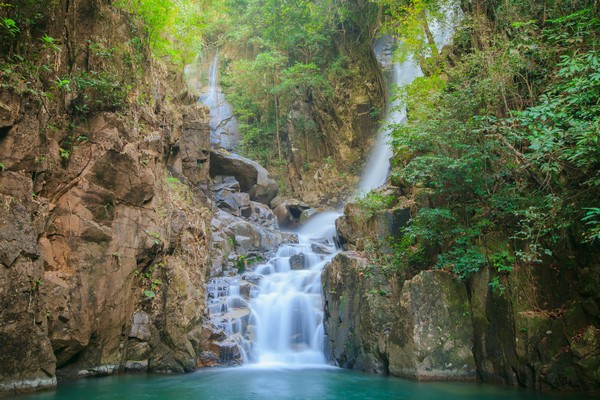
Besides a lovely scene of the descending water all through the year, Namtok Phlio National Park is a remarkable historic site of Thailand. Since it is the waterfall where the king Rama 5 visited for 12 times during 1873 – 1881 A.D. And, he admires the place as the most beautiful waterfall among those he had visited. Additionally, the area around the Phlio Waterfall is the nature trail that is rich and diver logical of plants. So, it is another exciting learning center for any students or people in general to experience.
The story of Phlio Waterfall
Namtok Phlio or Phlio Waterfall National Park stretches over the region of Lam Singha, Khlung, and Makham district in Chantaburi province with 134.50 sq.km of space. The site is the rich forest surrounded by the numerous of towering mountains resulting in the weather is fresh and pleasant all year. The height on the top of the mountains is different high between 20 – 924 meters above the sea level. The highest peak of the site is at Map Wa Krok Peak with 924 meters in its height, and it is the source of water for many streams. The location is about 14 km from Chantaburi town with a good paved road along the way to the recreation place.
The Phlio Waterfall was declared as the 11th National Park in Thailand with the original name was Khao Sa Bap National Park. Then, Pajon Thanamittramanee, a former Chief National Park submitted the requirement to change the name to Namtok Phlio National Park. The reason to use the name as Namtok Phlio because Phlio Waterfall is a gorgeous natural fall with plentiful of water all through the year, and also it is well renowned in general as the highlight of the national park. And on September 29, 1982, the national park committee approve of replacement the name to Namtok Phlio National Park finally.
About Namtok Phlio National Park
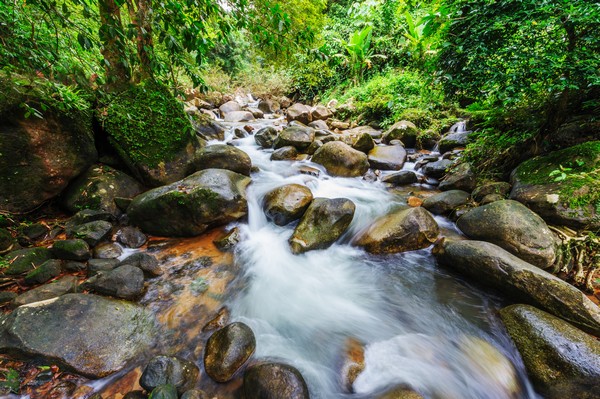
Phlio is a large and charming waterfall with plentiful of water throughout the year. The fall made up of two currents, one descending thoroughly along the stones whereas another which is smaller only flows from a 20-meters cliff. Then, both streams merged in the clear pond that allows seeing through the 2 meters of its depth at the bottom where many of rocks and sand are laid down. Moreover, there is the various size of freshwater fish mainly is Mahseer barb swimming living in the water both the cascade and stream. The charming of the scene strikes the eyes of the visitors very much. So, the place is fantastic to come and enjoy leisurely.
The word “Phlio” is Chong, a Western Pearic language in the Mon–Khmer language family, which means sand or sandy beach. However, it is assumed that the Philo Waterfall is named after the tree that regularly grows in loamy sand. It is a vine with flower and a raisin size fruit in red-yellow.
Charming of the waterfall
Namtok Phlio National Park is a clutter of an abundant tropical rainforest environed by agricultural land and residences; as a result, there are a few numbers of wildlife in the area. Anyhow, the principal species of plants appear at the site. There are Malva Nut (Scaphium macro podium Beaum), Red Meranti (Shorea Henryana), Wild Almond (Irvingia malayana), Kokithma (Hopea ferrea Laness), Red Rubber (Dipterocarpus turbinatus Gaertn. f.). And Agarwood (Aquilaria Crassna), Coreopsis (Coreopsis Tinctoria), Garcinia speciosa Wall, Chamuang (Garcinia cowa Roxb), Indian Oak (Barringtonia acutangula (L.) Gaertn.), Pterocymbium tinctorium (Blanco) Merr., and Keledang ( Artocarpus lanceifolius Roxb. And since it is an abundant and moist forest resulting in its weather is cold and pleasant all through the year with the temperature between 26 – 30 degrees Celsius.
The location allows the tourists to visit through of the year in particular in the rainy season which is perfect for photo opportunity caused by the plentiful water.
Other Attractions within the National Park
There are many more attractions located in the Namtok Phlio National Park that are a good idea to visit as well.
1. Phra Nang Ruea Lom Stupa
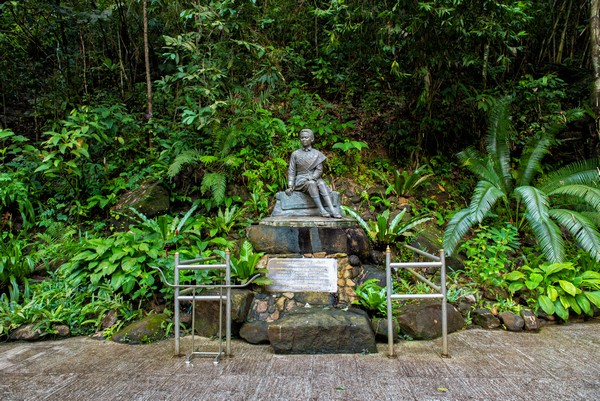
Phra Nang Ruea Lom Stupa stands in the area of Phlio Waterfall. It was constructed during the reign of King Rama 5 in 1881 as a memorial to the Queen Sunandakumariratana. The stupa is a house to pack the queen’s ashes. The King Chulalongkorn visited the fall in 1874, and he hugely appreciates the beauty of nature and environment of the site so much. And there were more than 10 times of his journey to the place after then.
The cause that he chooses the design of the memorial site as a pyramid-shape since his concerns about the duration of the stupa that locating in the middle of the wood without any carer. And the pyramid shape is renowned for its durable so the memorial stupa will be last long as well.
2. Alongkorn Chedi
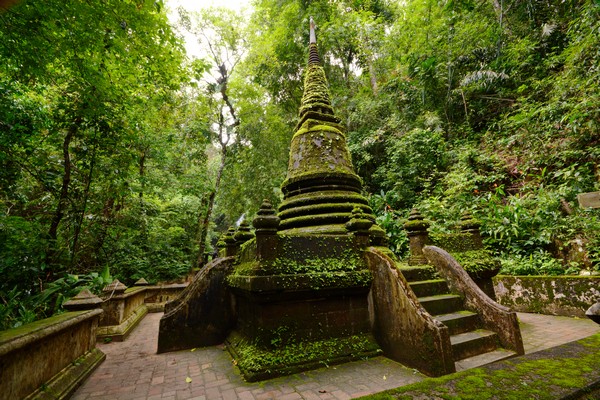
The King Chulalongkorn and The Queen Sunandakumariratana graciously ordered to construct the pagoda from the laterite at the area of the cliff in 1876 as a remembrance for the trip with the queen. And he named it is “Alongkorn Chedi”. As mentioned previously, the Phlio Waterfall is, so admiral for the King Rama5 and he made many trips to the site. The King mentioned that “There are three locations that I used to visit which are Pi Nang, Chang Islands and Si Phya; nonetheless, there’s no any place is beautiful as this place. It would be my please to sit and sight here until dusk since it’s cool and pleasant.”
3. Ang Sarn
About 300 meters from the National Park Office. There is a shrine locates next to the brook. In the old days, it was a flawless pavilion that King Rama 4 graciously ordered to build. However, it eroded by the water, and finally, it was wiped out by the stream in 1974.
4. Ang Song or Ang Hong
It locates about 200 meters from the Ang Sarn. The site is a small cascade guttering from the limestone cliff looks similar to the swan’s tail (Hang Hong in Thai). In the previous days, the pool was the proper size for water playing that the King Rama4 and 5 used to bathe in the pool so that it is named as Ang Song which means a bathtub.
5. Phra Narai Cave (Narayana Cave)
The Narayana Cave is a 1 km in length. There is pure fresh water runs out from the cave. This source is 1 of 18 natural holy water sites in Thailand to be used in the purification bath of the king in the coronation ceremony. Unluckily, the cave is closed by the stone in these days, but the water still runs out from the cave through of the year.
Besides many attractive sites mentioned above, the national park features the visitors with an exciting nature trail with is about 2.5 km in its distance. The trail passes by many appealing spots from Narayana Cave the sacred source of water and end at the Ang Sila (the rock basin). Furthermore, there are two more waterfalls locate in the national park that are worthwhile to explore their charm as well which are Klang Waterfall and Atsachan (Miracle) Waterfall.
The Facilities at the Park
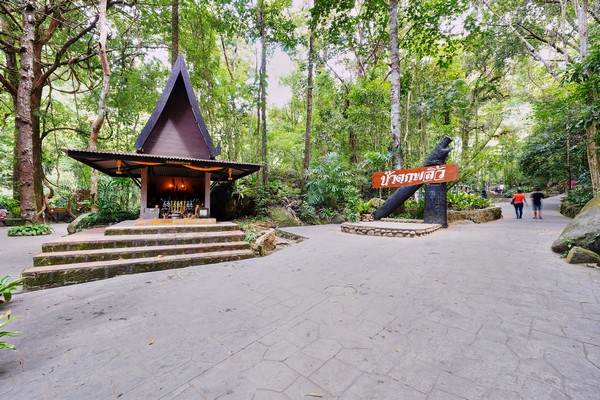
The national park provides the tourists with the tent and camping locations. They located in the area of national park office next to the viewpoint, National Park Forest Protection Unit 1 (Trok Nong Waterfall), National Park Forest Protection Unit 1 (Trok Nong Waterfall, zone 2), National Park Forest Protection Unit 3 (Klong Narai Waterfall), and National Park Forest Protection Unit 4 (Makok Waterfall).
At the National Park Forest Protection Unit 1 (Trok Nong Waterfall, zone 2) where is about 23 km from the national office, has 2 building of youth house that is ideal for the school outing and field trip. Each structure consists of 2 bedrooms – one is for 2 persons, and another is a large size with about 28 persons of its capacity. Plus 1 storage room, 1 lounge and 8 bathrooms with toilet.
Accommodation
The location at the national park office offers a campground style accommodation for students and visitors in general. The building contains 15 room for the male and 15 rooms for the female with the shared bathroom and toilet located outside the building.
For camping facility reservation and any further information, please contact the national park office or tourist center that open daily between 8.00am – 4.30pm.
There are snacks stalls providing refreshment, coffee, and snacks at the park, too.
According to the condition of the area is slope resulting in the limitation for parking that is reserved for the tourist who uses the accommodation service only. While the visitor who visits the site in the daytime need to park outside the area of the park that is the parking operated by the municipal government and private with the fee. However, there is parking at the shops with free of charge for the visitors who shop at the shop.
Admission Fee
The admission fee of the Phlio Waterfall National Park is
- Thai: Adults is THB 40 / Children is THB 20
- Foreigner: Adults is THB200 / Children is THB100
*note: please recheck at the National Park office.
How to Get Namtok Phlio National Park
By Car:
From Bangkok: there are 2 directions to reach the Phlio Waterfall National Park which are
1. Uses the highway number 3 (Sukhumvit Road) route Bangna – Trad until you reach the 347th km. Then turns left and drives about 2.5 km will arrive at the destination. The total distance is 340 km approximate.
2. Uses the road number 317 and gets to the route Ban Bueng – Klaeng. Then enters to Chantaburi along the Bangna – Trad road until the 347th km and turn left and heads toward more about 2.5 km will arrive at the destination. The total distance is 270 km.






